Small’s Dairy & Small’s Poultry Farm
Posted on July 9, 2025 by Jenny ONeill
By Lois Bradley Small
Rev 5/10/2025
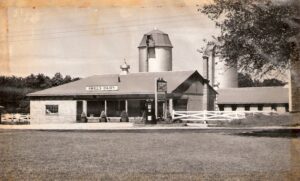
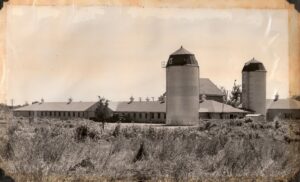
Reuben Small, son of Elisha and Hannah (Crowther) Small was born in Fall River, Massachusetts on November 25, 1882. He spent his youth there before moving to Lehighton, Pennsylvania where he met and married Mary Esther Koch in 1905. After obtaining agricultural schooling in Allentown, Pennsylvania and Ontario, Canada he, along with his brother-in-law, William D Koch, opened a dairy in 1913 in Lehighton, Pennsylvania under the name of Small and Koch. For almost 20 years it was a successful business until several missteps took place. He was taking money from the business to have built a very large brick house and not paying the suppliers. Somewhere around the same time he started seeing the business’ bookkeeper. When the suppliers found out where the money was going they forced the company into receivership and when Mary Esther found out about her husband’s affair she obtained a divorce. Right after the divorce was final in 1933 he married the bookkeeper and moved back to Fall River. It wasn’t long after moving that he began looking for property to again open a dairy. Fall River was too populated but Westport was the perfect place to be. Plenty of available land, yet close enough to be able to have milk routes to the neighboring larger towns.
On April 18th, 1935, as was recorded in Bristol County in Book 763, Pgs 365, Reuben purchased the Frederick Wordell Farm, located on the east side of Horseneck Road in Westport. This farm was bounded by land owned by Nellie Pettey & land of Elmer Gifford. The parcel contained acreage listed as ‘what it may’ and was the first of several purchases.
No record was kept of the cost of building the dairy. We estimate that the granite cement block cow barn was 300’ long and the dairy 75’ to 100’ long. The back loading platform was about 50’ wide as they could put 4 to 5 trucks there at a time. There was a large International generator that could run the operation if the power went out. A research of building prices in that time frame found that, “by the late 1940s, the national median home price had plateaued around $130,000, where it would remain roughly unchanged for the rest of the century.” [1] If we figure inflation from then to now and assuming it cost $250,000.00 (which seems to be a low figure) to build the dairy, barns and outbuildings, that amount would be over $ 5 million in today’s dollars.[2]
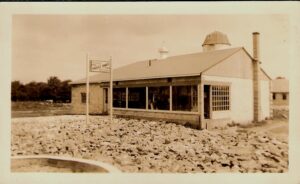
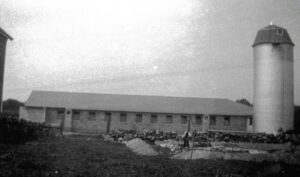
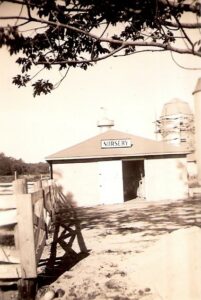
According to his equipment journal, beginning in September of 1936, the first thing he did was to have a well drilled. If memories are correct it produced 25 gallons per minute – far more than any of the wells that were ever drilled on any of his properties. This was followed by delivery trucks, tractors and equipment as listed.
The average wage for a farmer in Massachusetts in 1936 was $ 20.41 per month | |||||||||||||||||||||||||||||||||||||||||||||||||||||||||||||||||||||||||||||||||||||||||||||||||||||||||||||||||||||||||||||
It is unknown if they had milking machines or if each cow was milked by hand, however, since the first milking machine was invented in 1878, and Reuben was known for purchasing the most modern equipment, it is assumed that he had some form of machine to do the milking. What is in the center of the picture below appears to be a milking machine available at that time. It most likely is what is in the center of the top picture.
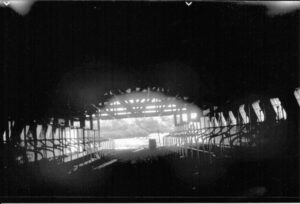
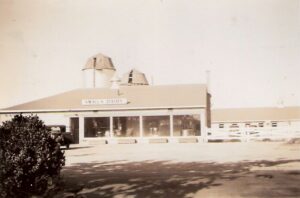
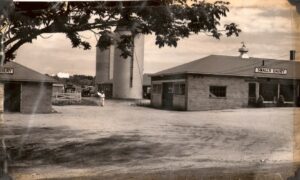
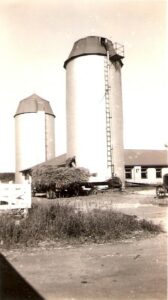
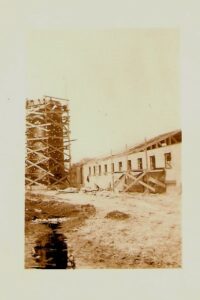
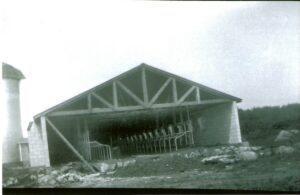
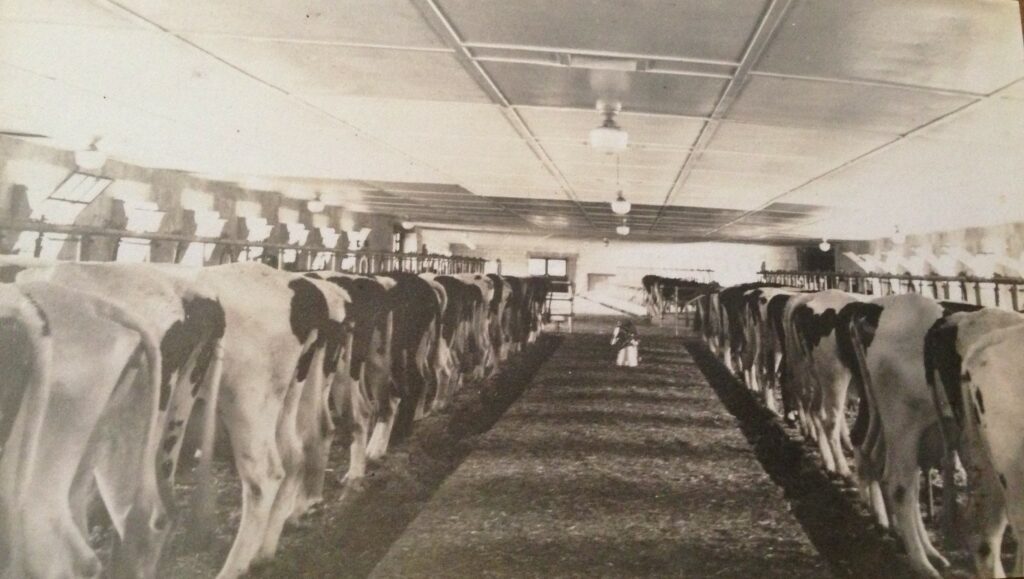
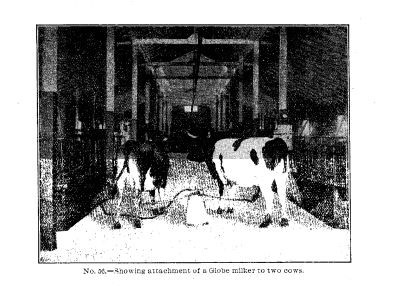
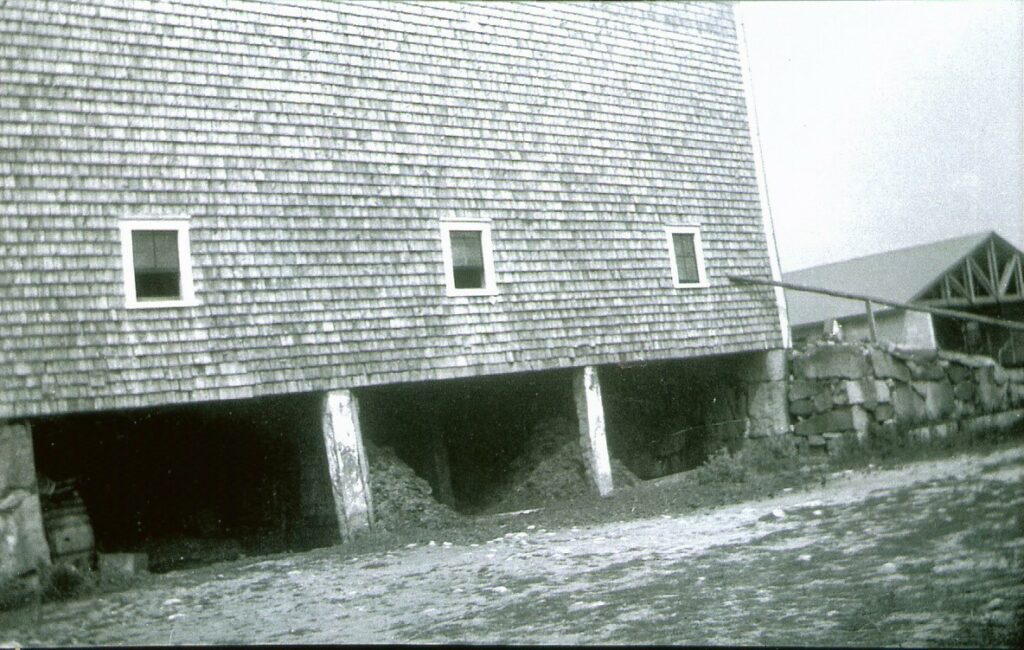 Large hay barn located to the right of the dairy
Large hay barn located to the right of the dairy
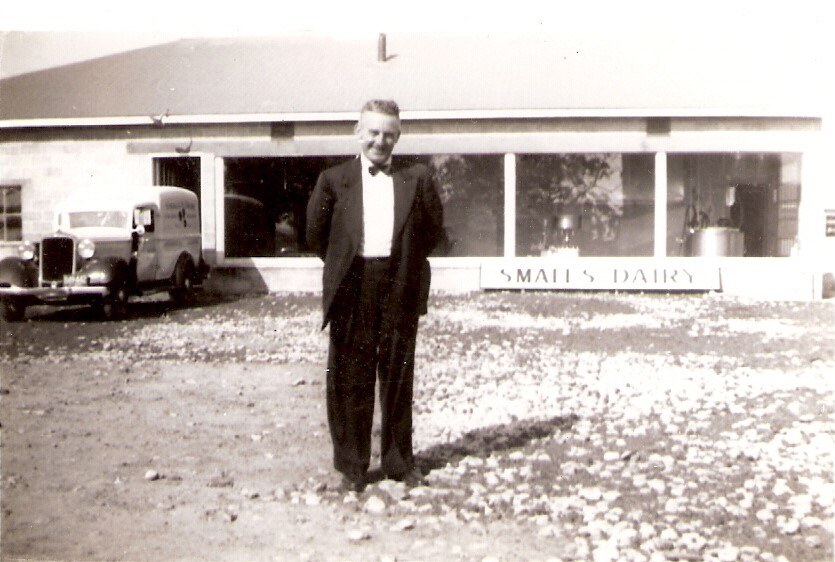
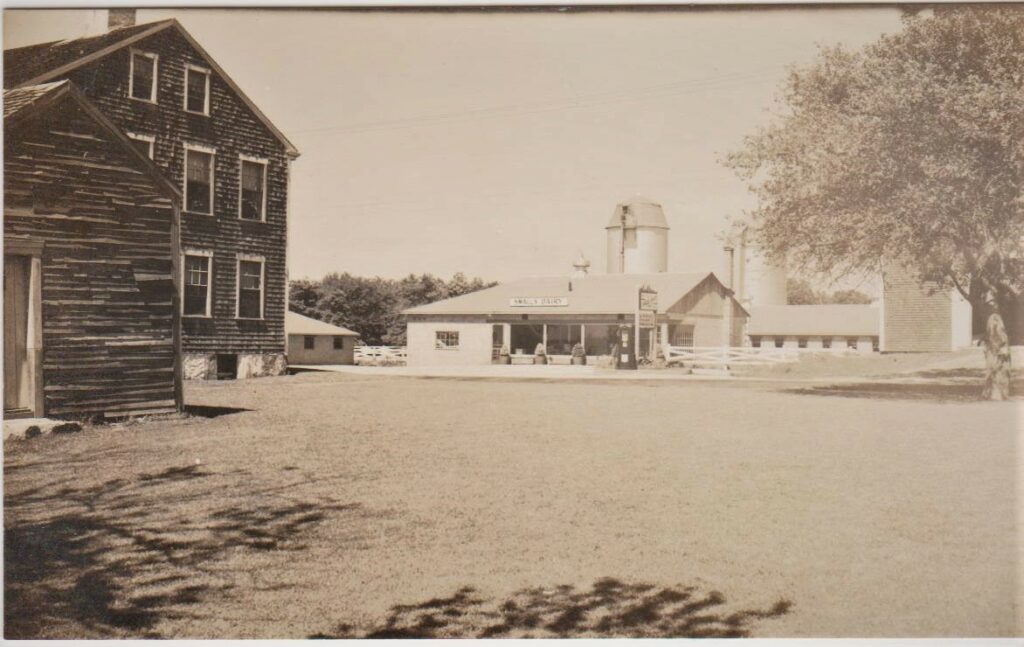
By January of 1937 the dairy began delivering milk in Fall River. A year later, he purchased additional property from the Wordell Family. And on April 14, 1940 he purchased what was called the Homestead Farm of Richard Almy, located about 3 miles south at 1227 Horseneck Road. The parcel which contained 185 acres cost $ 10,000.00. In all he purchased 6 farms and rented other land as well.
A $ 4,000.00 mortgage for the property to the Land Bank Commissioner was recorded in Book 886, Pg 360-363 dated August 30th, 1944. An interest payment of 5% was due semi-annually with 40 equal payments due on the loan. This mortgage was subject to a first mortgage held by the Federal Land Bank of Springfield in the amount of $ 11,000.00.[4]
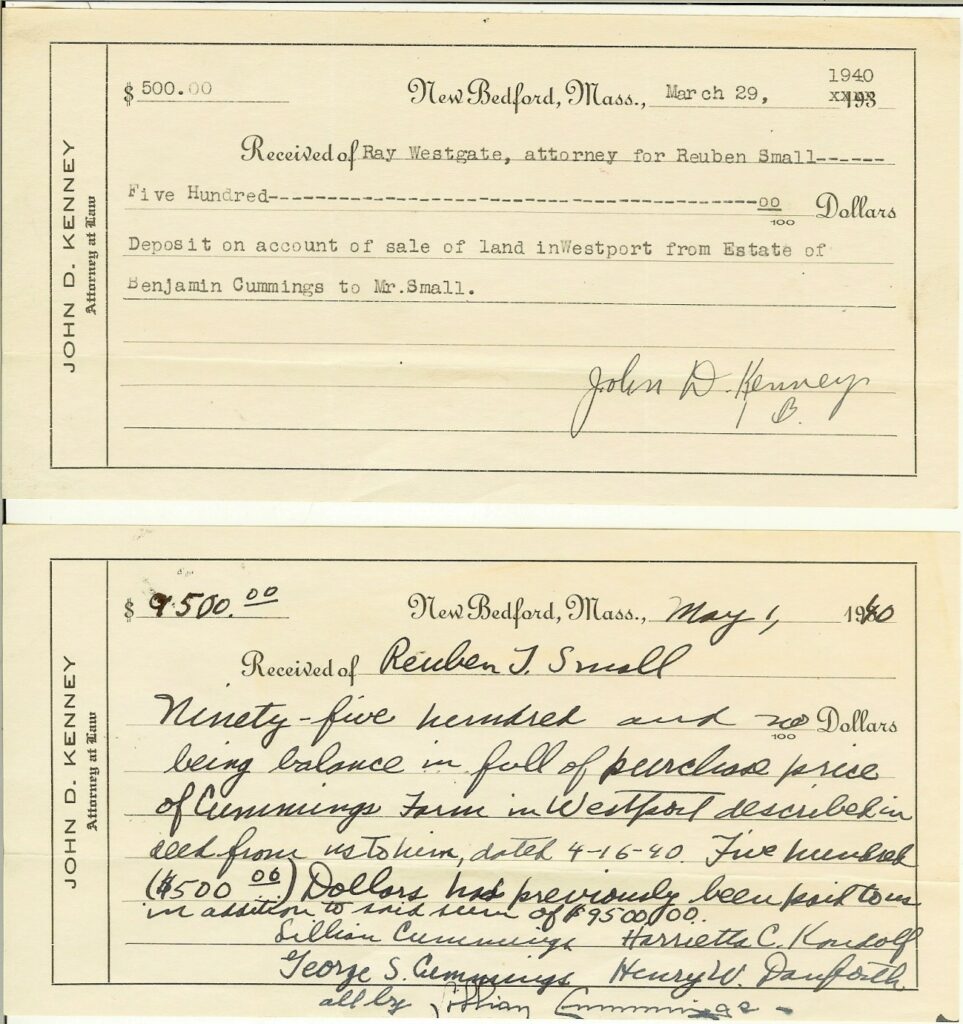
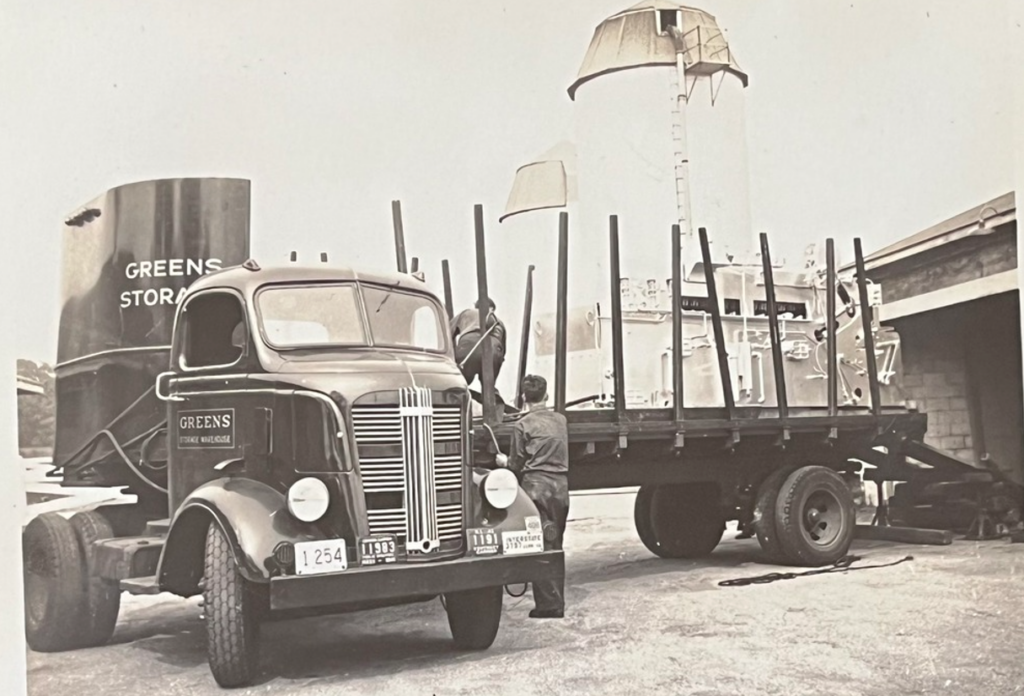
Picture is marked “Job at Smalls Dairy June 7, 1841”
(Clarence standing)
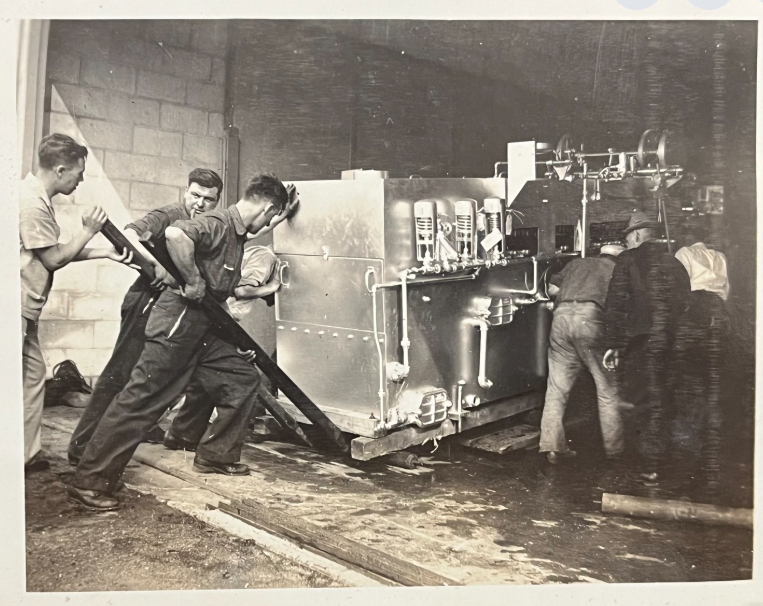
On left is Linwood Tripp, Joe Lindo, Clarence Gauthier
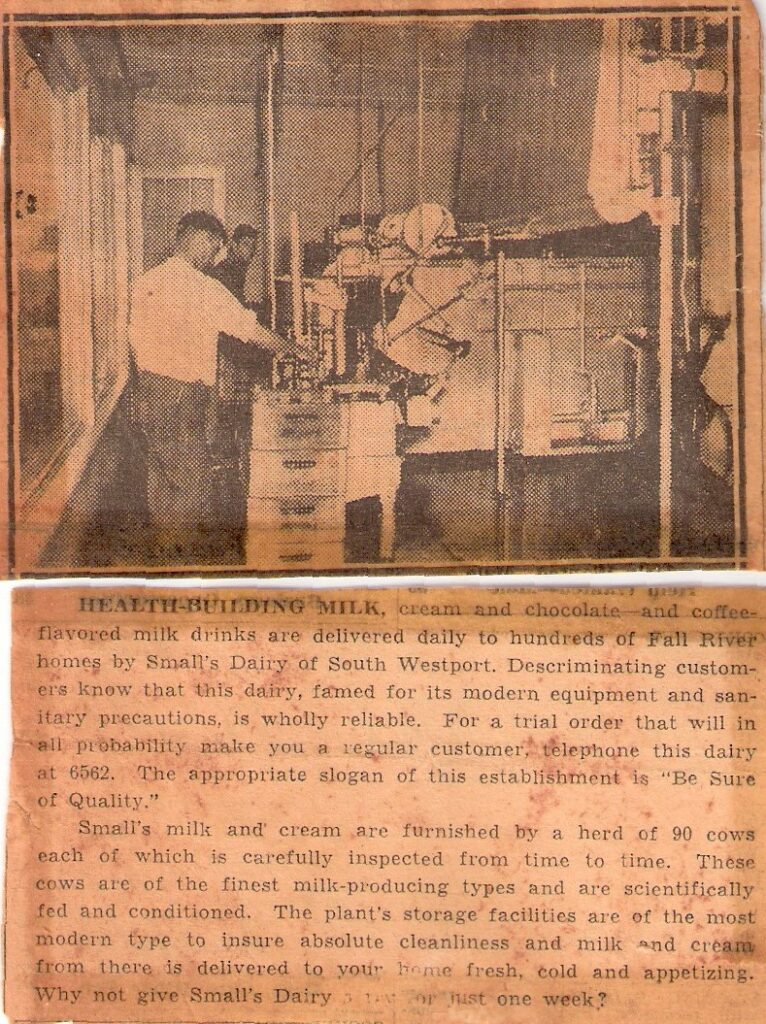
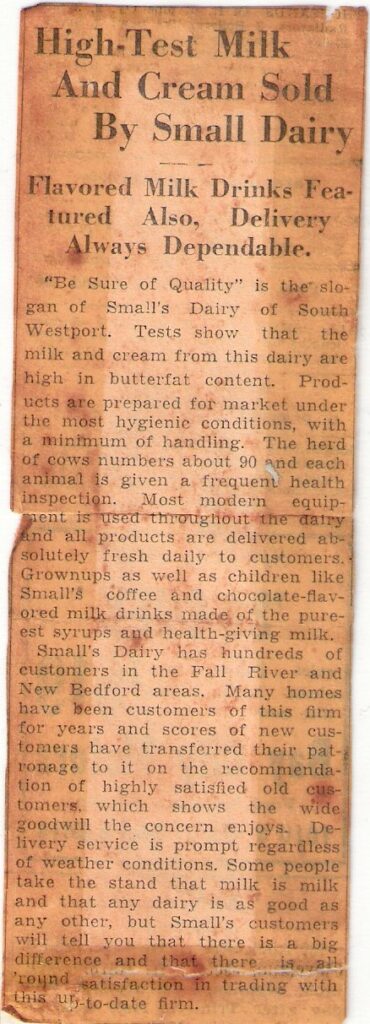
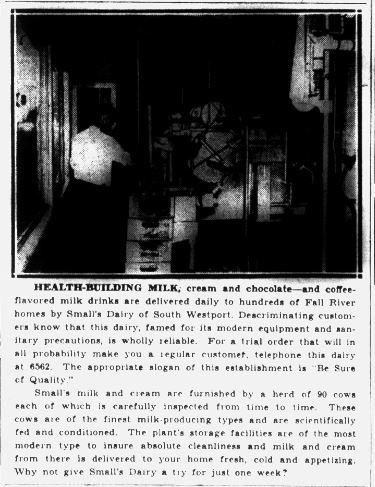
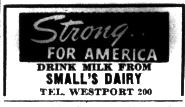
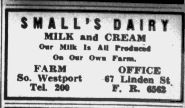

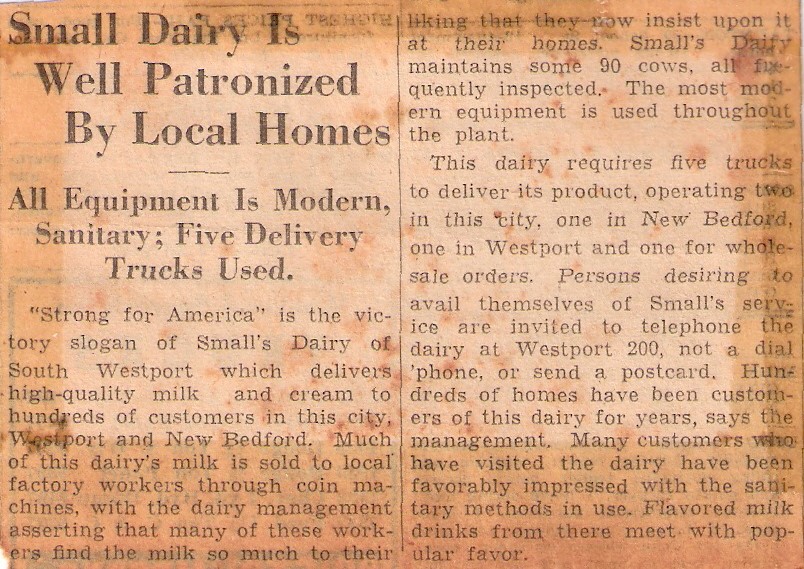
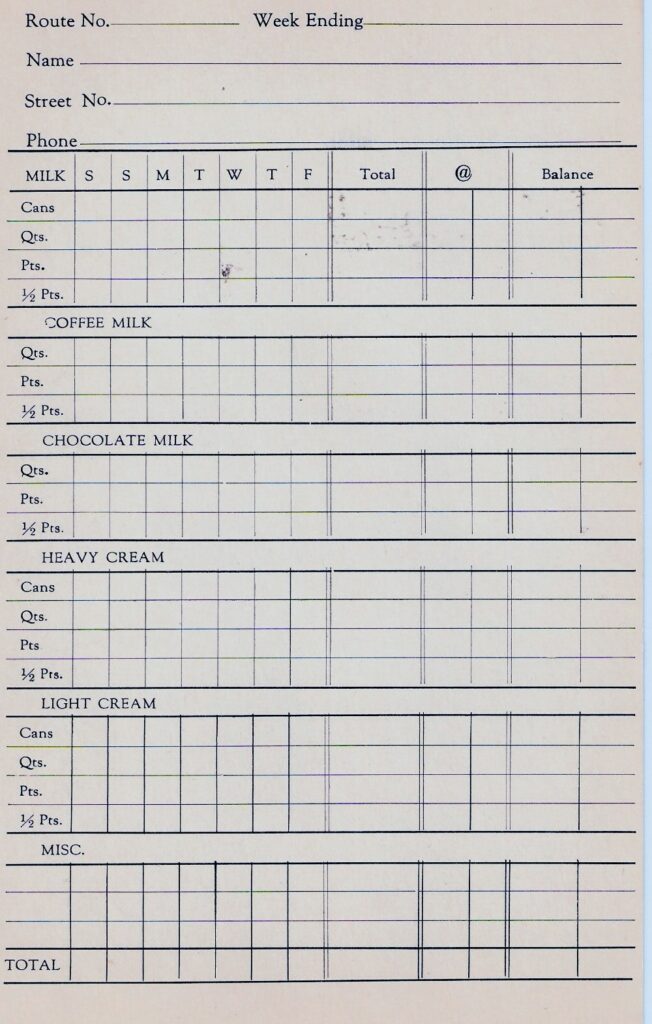
They sold White Milk, Coffee and Chocolate Flavored as well as cream in ½ pints, pints, quarts and cans
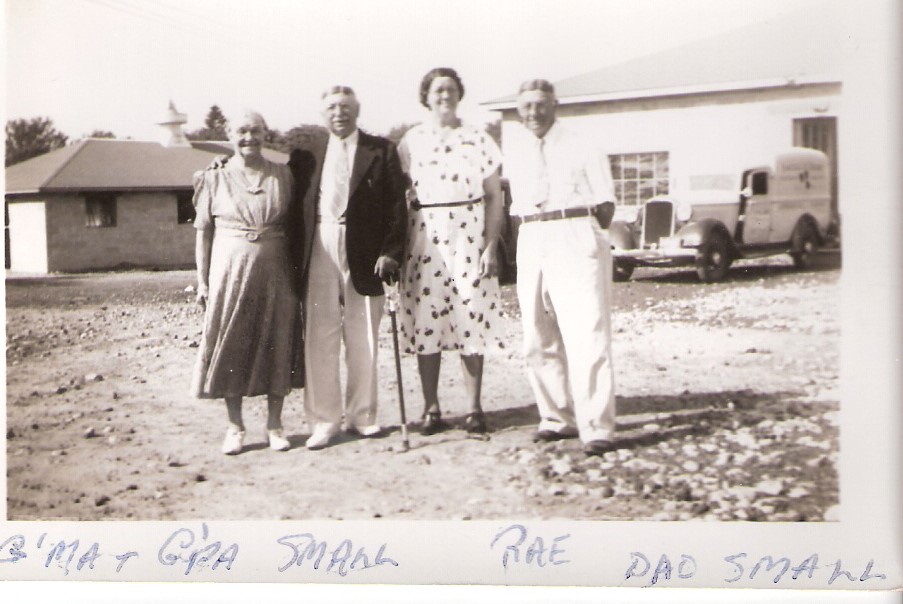 Proud parents Elisha and Hannah Small with Reuben and Rachel.
Proud parents Elisha and Hannah Small with Reuben and Rachel.
Along with many bank loans, Reuben received a great deal of monetary help from his parents.
Grandson Ronnie said he remembered a story he was told from one of the workers that Elisha said he could have built another 3 factories with all the money he put into his son’s entreprises.
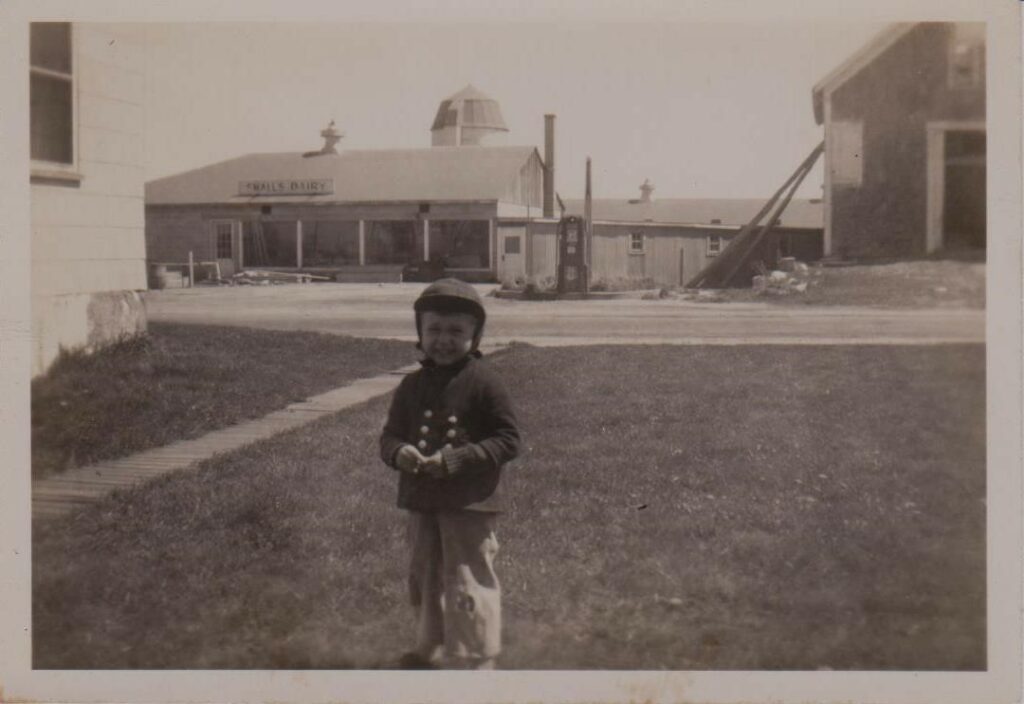
Luckily and strictly by chance, some of the records of the dairy operation for 1943 and 1944 have survived. They were in an old ledger book that had many unused pages. When we opened our marine business, Bill gave us the book so we would have a place to start our bookkeeping. Although I must have read what was in the front of the book, I never paid attention until I recently picked up the book to see the exact the date of when we started our marine business. What a surprise to find it was a Small’s Dairy ledger! It’s strange how things work out.
The following pages are from that bookkeeping ledger. They had established 4 milk routes and also sold it in coolers as well as in various factories, the YMCA, the Grange, a Church and Ruth’s Grille. A commission was paid to the factories and the YMCA.
It appears that by year end 1942 the total income was $4,966.26 with expenses of $2,323.71. As the entire year is not there, the figures can not be checked.
The month of November as shown in the following scans had a total income of $3,431.63 with expenses of $3,458.55. He had 14 employees whose weekly salaries ranged from $1.00 to $30.00.
Some of the items I found of interest include:
Telephone $3.87
Gas and Electric $77.50
Vanilla $2.00
Sugar $11.70
Gas for truck #2 $4.80
Gas truck #1 $3.83
Repair truck #4 $3.25
Braley’s Creamery $51.00
Income
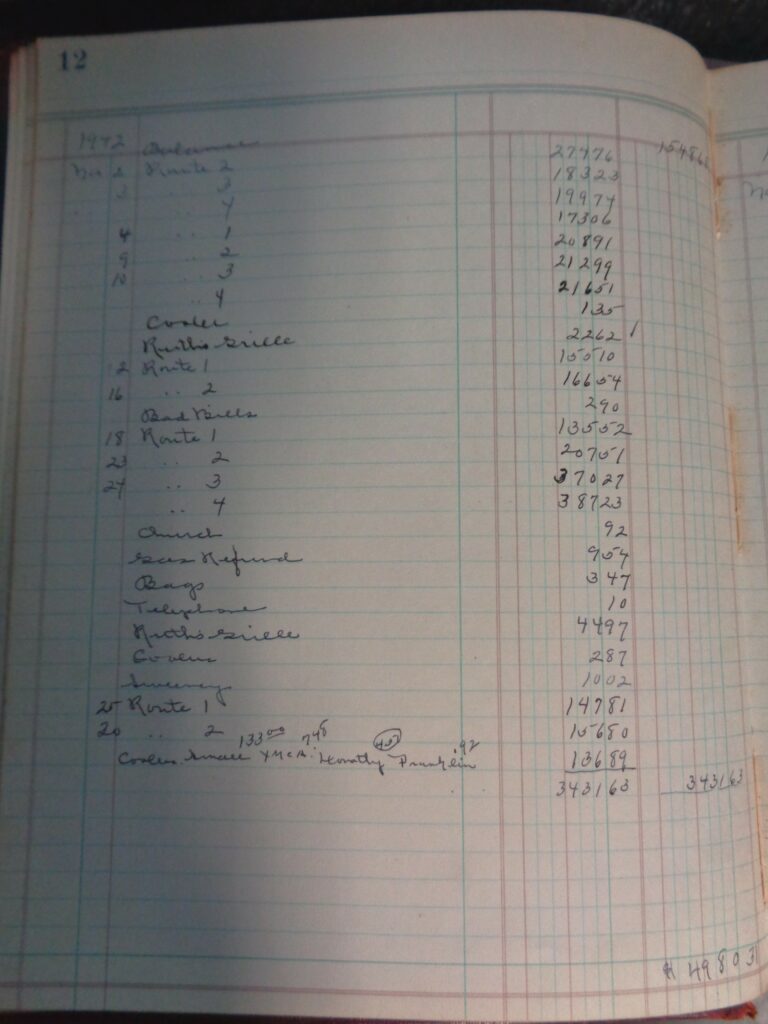
Expenses
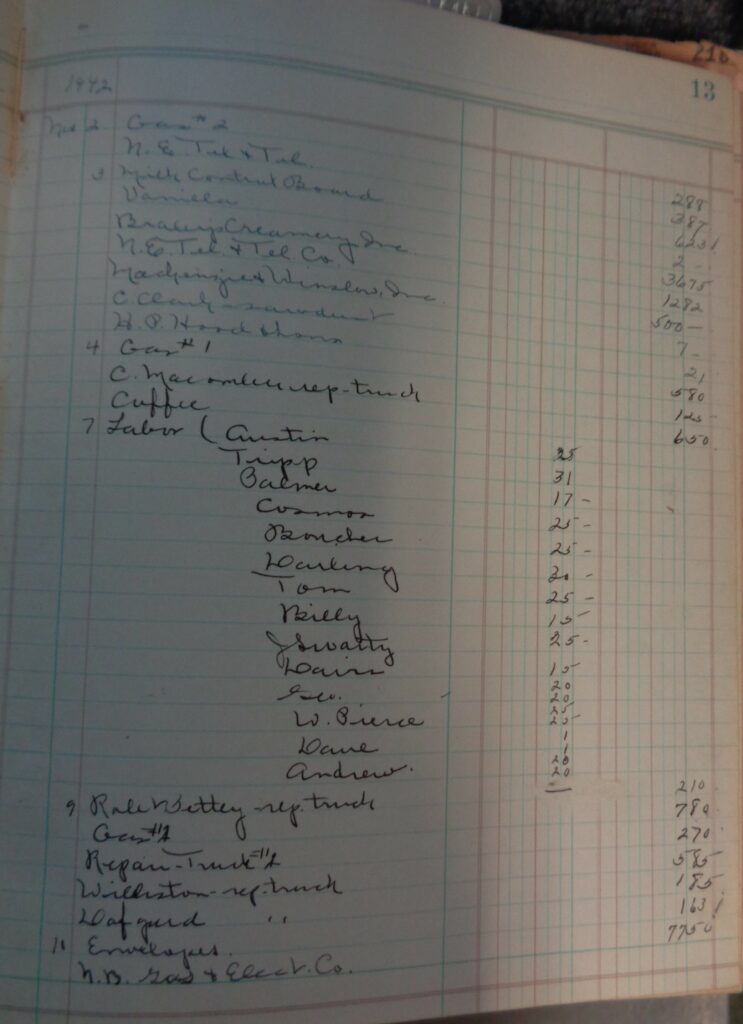
Expenses
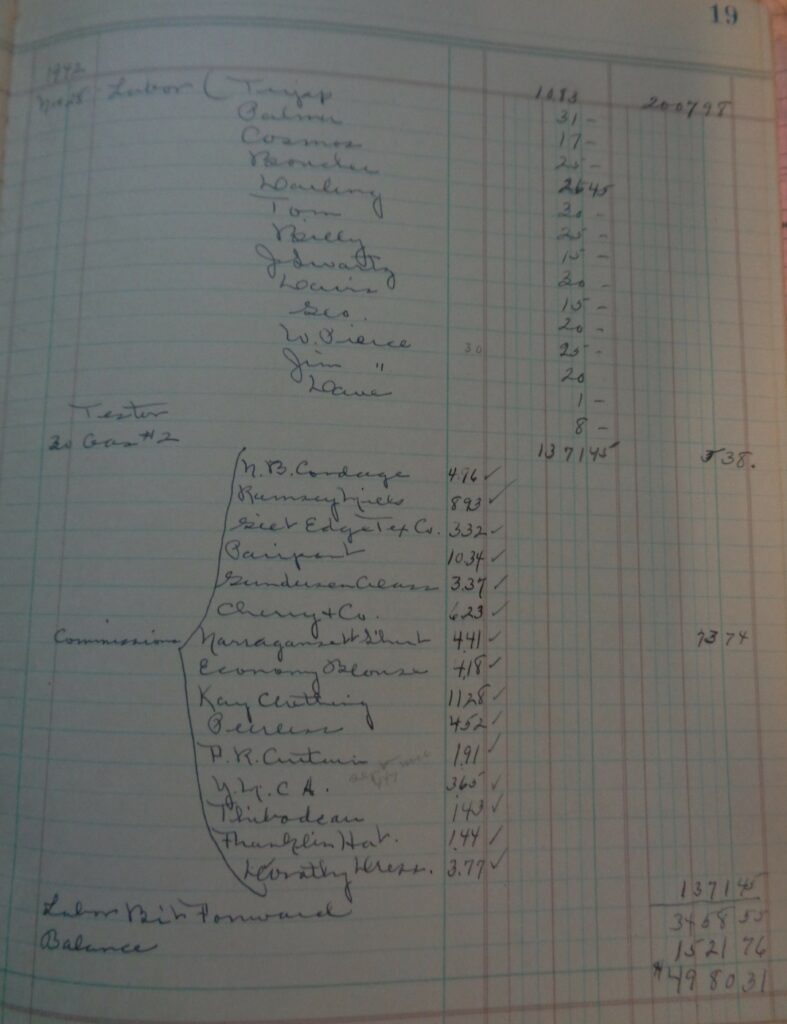
The war years brought a shortage of able-bodied hired hands and according to one of the newspaper articles included, they had to reduce the number of cows they had as there was not enough people to run the farm.
In doing some research I found that the average cow could eat 24 to 30lbs of hay per day. In the end, Reuben had 80 cows. Those 80 cows could eat between 1920 to 2400 lbs per day. If the bales weighed 40 lbs, it would be 48 to 60 bales per day and if the bales weighed 75 lbs they would eat 26 to 32 bales per day. If he did not have any silage and was only feeding hay in the winter, he could have needed as much as 7,200 bales in 4 months. Much more than only a couple of people working the farm could accomplish.
After only operating the business for 10 years, Reuben made the decision to close the dairy. As in most families, there are some conflicting stories which have been passed down through the generations. The reason that the dairy was closed was one of the stories which does not quite make sense.
We were told the following by Bill: He, Bill (who had moved from Pennsylvania to Massachusetts to help his father in 1945), had been supplementing his income by raising a few chickens and selling their eggs along the route while he was delivering milk. At first Reuben thought that Bill was stealing from him as he knew that Bill didn’t have enough money from the little wages he was being paid to fix up the house he was living in at 1227 Horseneck Road. Once he learned where the extra money was coming from, Reuben decided to become a chicken farmer. Bill said that one day when he went to milk the cows, they were all gone. This cannot be entirely true as the cows and equipment were auctioned off which couldn’t be done overnight. Also the newspaper article said that Reuben already had 1000 chickens.
Perhaps he was just tired of having a dairy and cows. Perhaps he thought that being a chicken farmer was easier or more profitable. Most likely, he closed the dairy because of lack of workers.
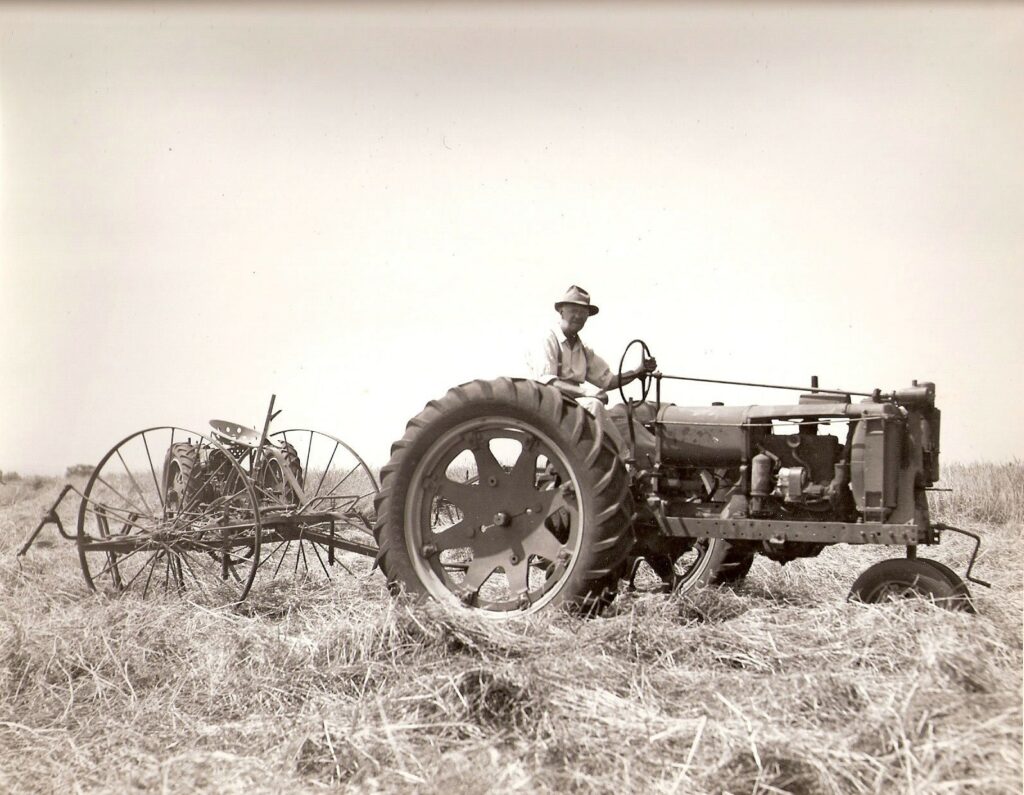
Reuben on his Farmall 14 tractor pulling a hay tedder
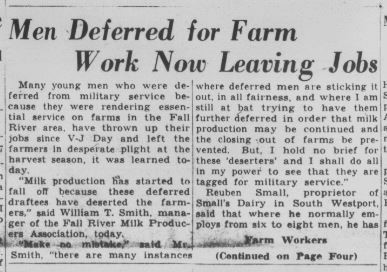
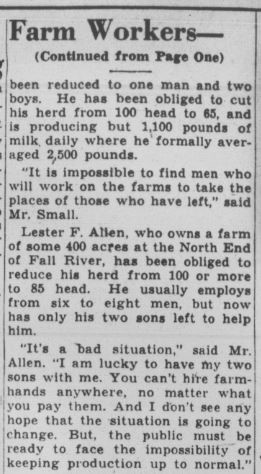
Whichever the correct story is, all the equipment from the dairy was removed or sold at Public Auction on March 1st, 1946.
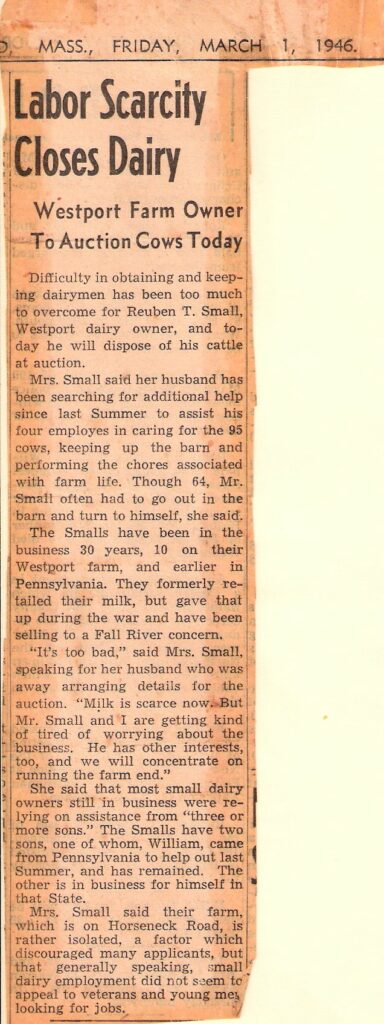
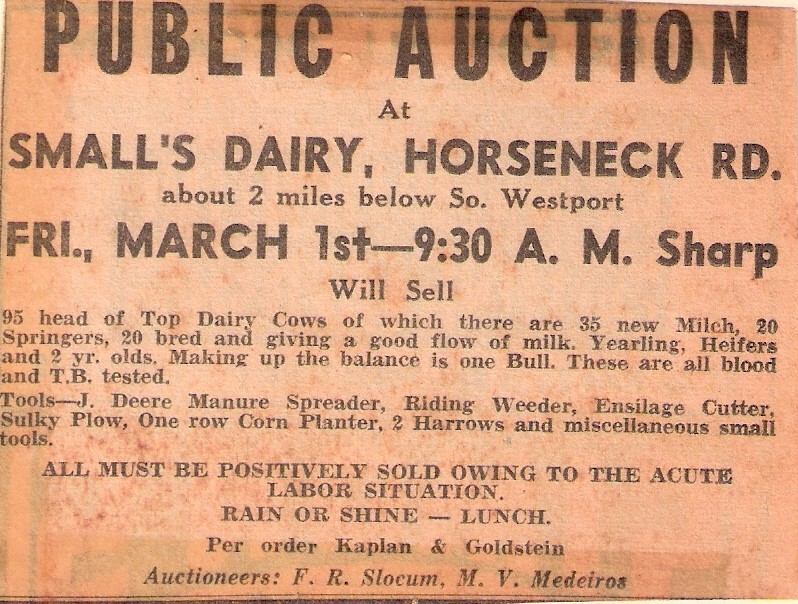
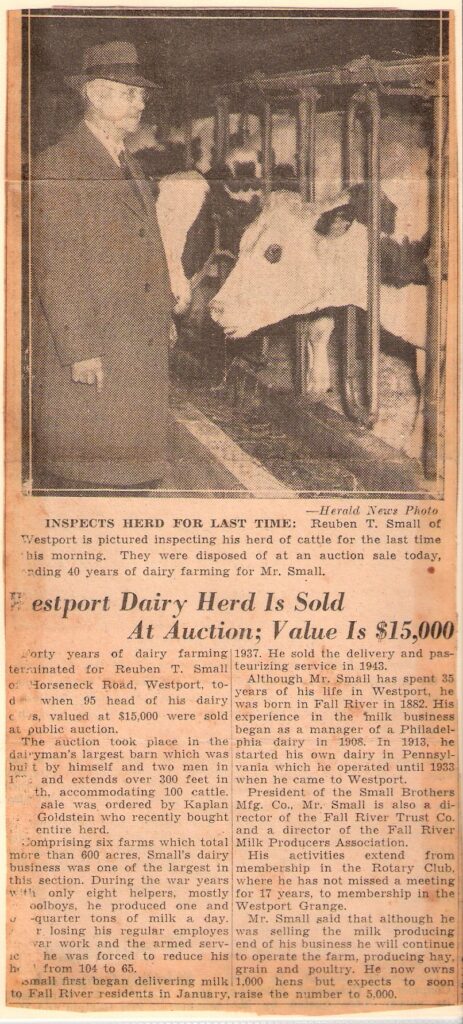
The hand written list is the final tally of the equipment & machinery sold. $10,467.25
The dates noted are the original purchase dates.
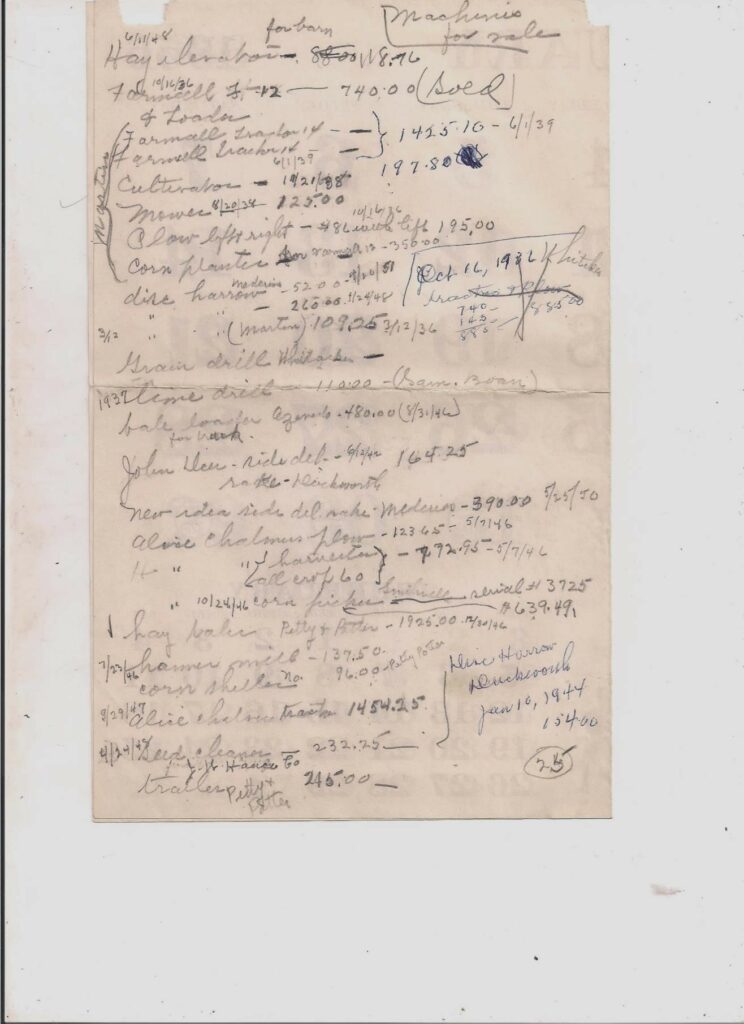
Small’s Poultry Farm
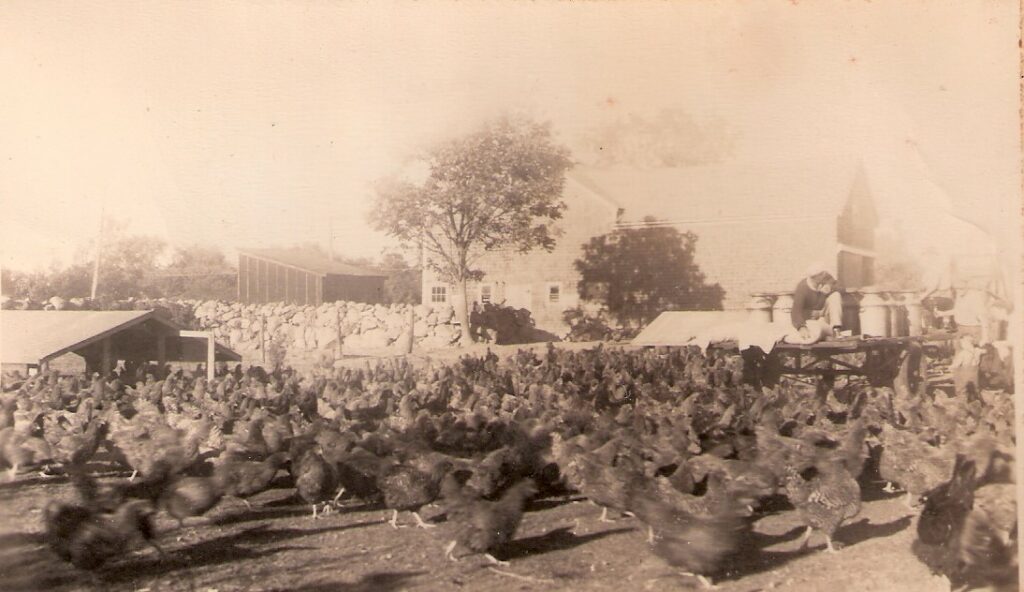
It was now time to start another new chapter in the life of Reuben Small. The barn now empty of milking stanchions and cows was converted into a large chicken house for the young chicks. A raised heated floor was installed where the chicks gathered under to keep warm. It was about 4’ wide and 100’ long with 6 pipes running beneath it. A furnace was in one of the other buildings and had two – 2” water pipes going to these 6 pipes. One was a feed line and the other a return line. These pipes ran under the raised floor and the hot water running through the pipes kept the chicks warm. We highly doubt that the furnace ever shut off.
Chicken feeders were added along with nests for the chickens to sit in while they were laying their eggs. Many outdoor shelters were made for older range free chickens.
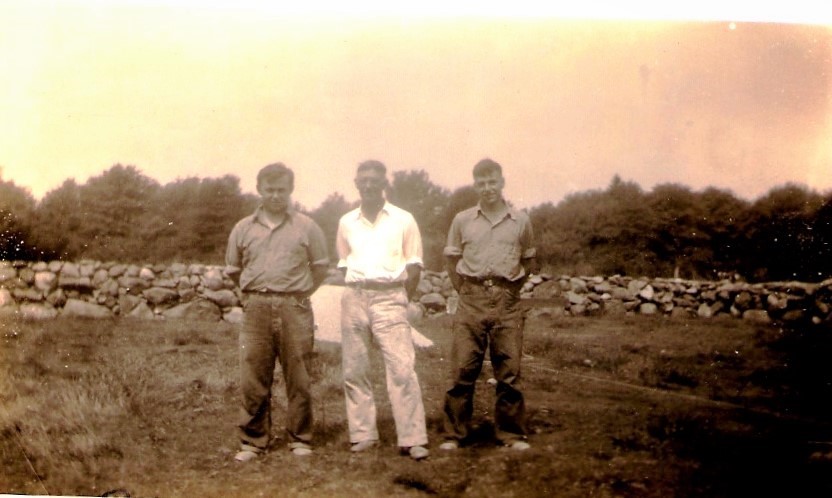
Bill, Reuben and Harold Small
The cow barn by Bill’s house at 1227 Horseneck Road was converted into a chicken house. It consisted of the bottom 3 floors housing the chickens. The 4th floor was where the grain was stored. Automatic feeders went around each of the lower floors. They were ‘troughs’ which had a moving chain running through them. The grain was poured into a shoot on the upper floor where it funneled down into the troughs. The grain was brought to the upper floor by a chain operated elevator. As far as we remember, this chicken house held about 14,000 chickens.
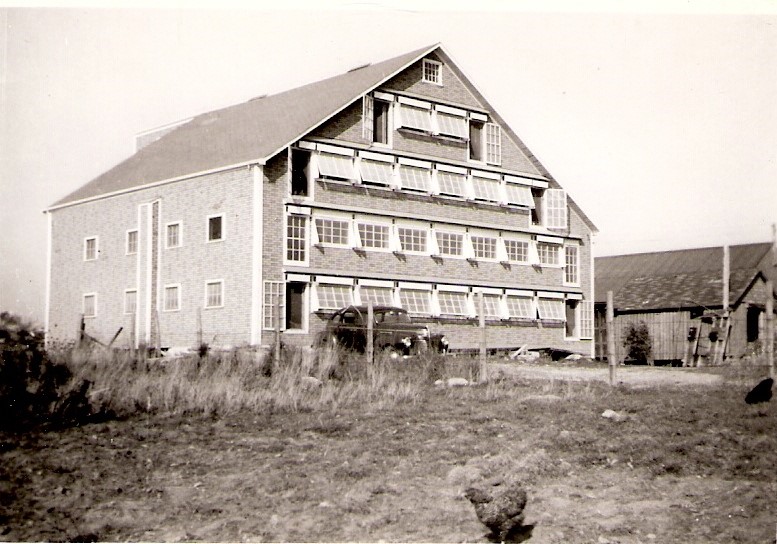
The new chicken business required different equipment from what he had for the cows and dairy, so he purchased the following:
| 5/7/46 | 1- 512255 A Cromwell #60 All-Crop Harvester, bagging attachment & | $772.95 |
| hitch for Farmall Model H Tractor Serial # 114873 | ||
| 1- 503602 Hart Scour Kleen for #60 All-Crop Harvester bag attachment | ||
| Serial # S-59197 | ||
| 7/23/46 | Hammermill Low Cyclone 2-way bagger | $137.50 |
| 8/31/46 | Bale Loader | $480.00 |
| 10/1/46 | Farm Trailer | $215.00 |
| 10/24/46 | Allis Chalmers Two Row Corn Harvester | $639.49 |
| 6/19/46 | Straw Windrower | $20.67 |
| 12/30/46 | 50-T Pick up Bailer | $1,925.00 |
| 7/11/46 | Pasteuray Corp Electronic Unit | $165.00 |
| 7/25/47 | Eviserator – buton | $115.00 |
| 7/25/47 | Egomatic Grader | $402.78 |
| 8/18/47 | 15KW G151 International Gas Generator with Automatic Transfer Switch | $1,950.00 |
| 9/29/47 | Allis Chalmers Tractor Model WC #290520 | $1,454.25 |
| 11/7/47 | Waxer – Buxton | $266.00 |
| 2/15/47 | Tank | $50.00 |
| 5/15/47 | Saw | $149.95 |
| 2/15/47 | Corn Sheller | $96.00 |
| 1/15/48 | #99 x 0107 Hardie Estate #99 Sprayer – 50/4 Tank & Transfer | $391.00 |
| Capacity 4 gal per min,, pressure 300 lbs. Model A Briggs & Stratton | ||
| air cooled engine 150 gal wood tank | ||
$ 9,230.59 [15]

The original ‘Almy Homestead’ farm house was un-occupied and was also converted into a chicken house. It was a beautiful old 3 story home with a huge fireplace in the center. According to the stone pillar at the entrance, it was built in 1780. I was told that it was old, drafty and not insulated. The only heat was from the fireplace. I never asked, but it is questionable if it had running water or electricity.
I believe that I was told that, after the very 1st load of new chicks were delivered, a farm hand discarded a cigarette and caught the newly laid hay and shavings on fire. The house burnt to the ground and was never rebuilt.
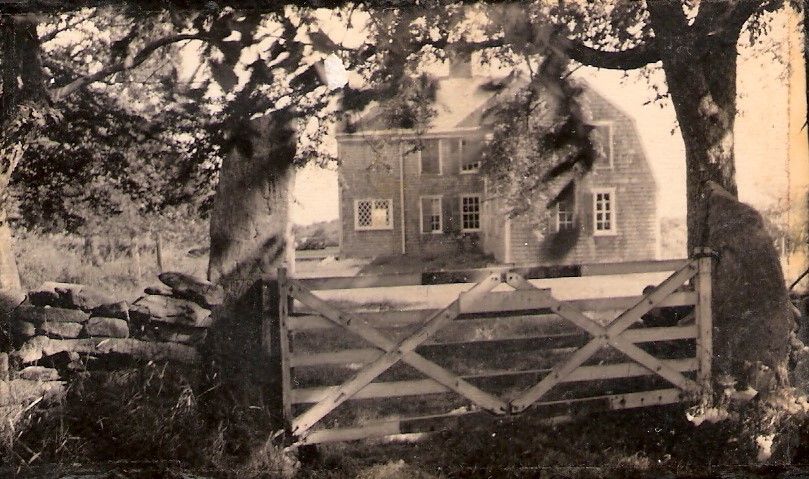
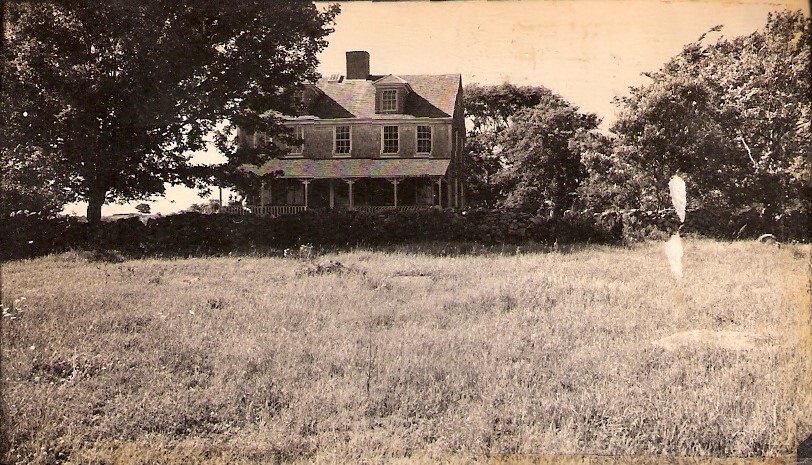
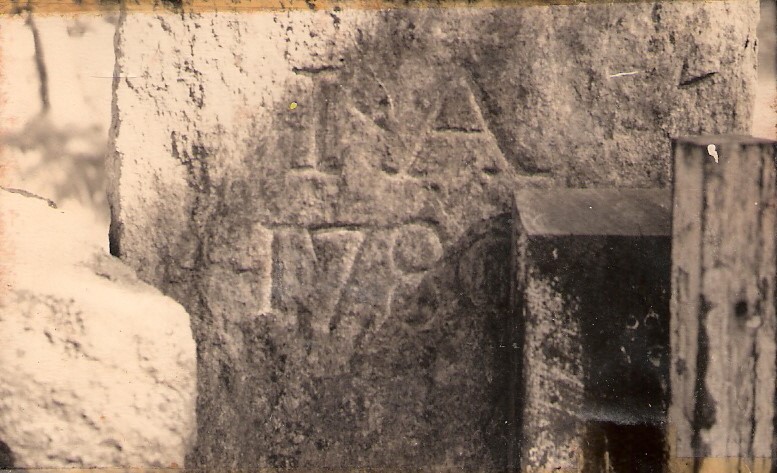
After the fire
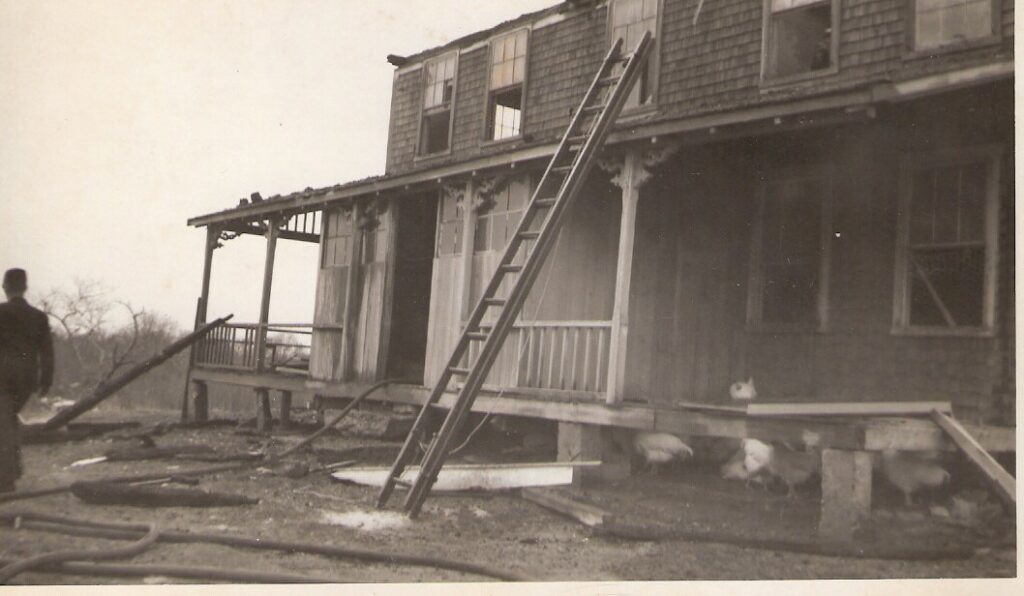
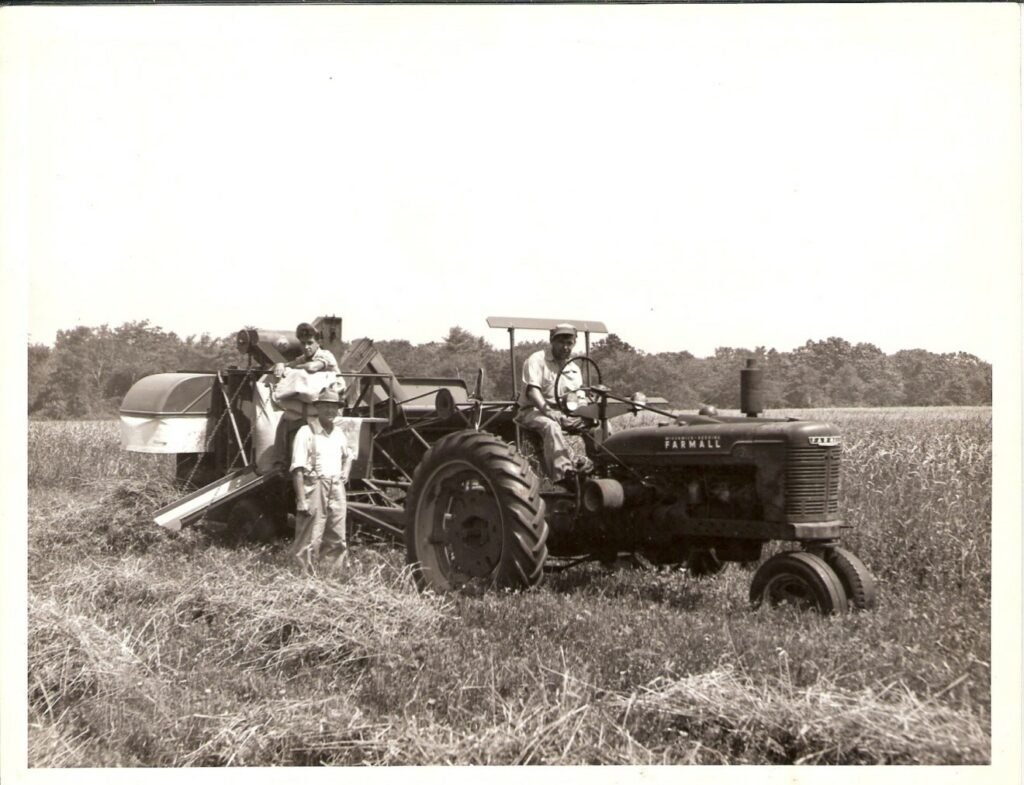
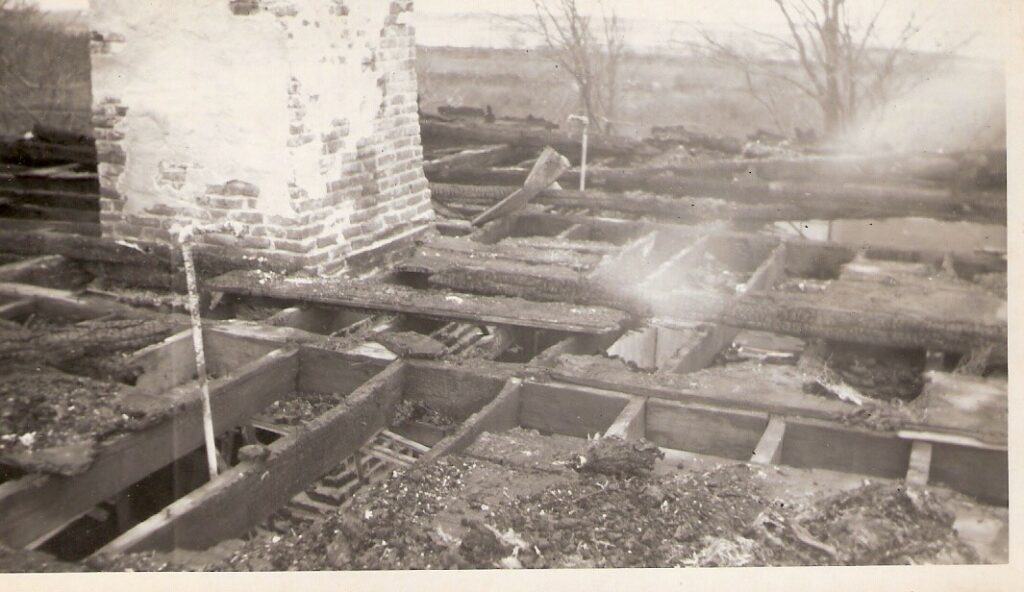
They made their own feed, a corn & wheat blend. A Hammermill Sheller took kernels off the cobs. Wheat & rye were put into 100 lb bags. A grinder was located in the ceiling of the top floor of the chicken house. Even with the 5 farms that he owned, there was never enough land and additional fields were rented from the Tuckerman Family.
In 1953 the Board of Selectmen granted Reuben a Slaughterhouse License.

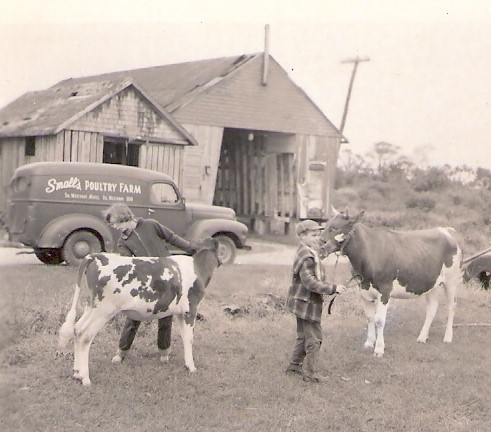
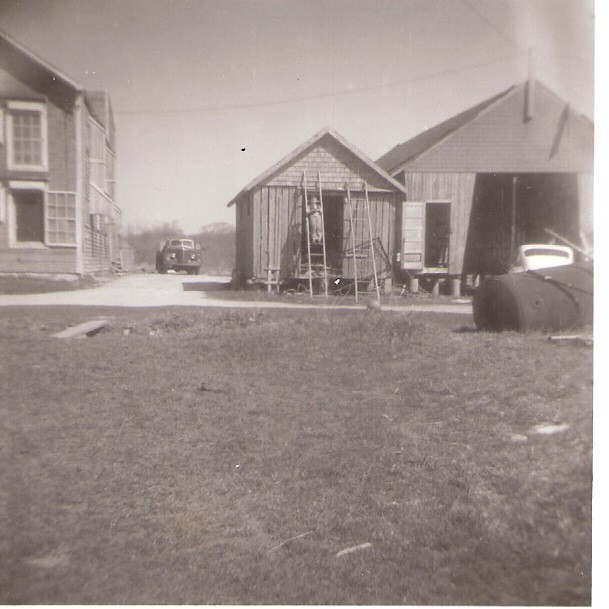
Corn was harvested and stored in the two corn cribs above[19]
According to the following story and what was not printed in the newspaper, many chickens were being stolen from area farms, not just 5 or 10. It is possible that the 500 or so that Mr White had were all stolen. Not only chickens were taken, but also the grain to feed them! Finally Bill had enough. He rigged an alarm to ring in his bedroom if the chicken house door was opened. The rest of the story was printed in the Fall River Herald News. The buckshot made it very difficult for Mr.White to sit for quite sometime after.
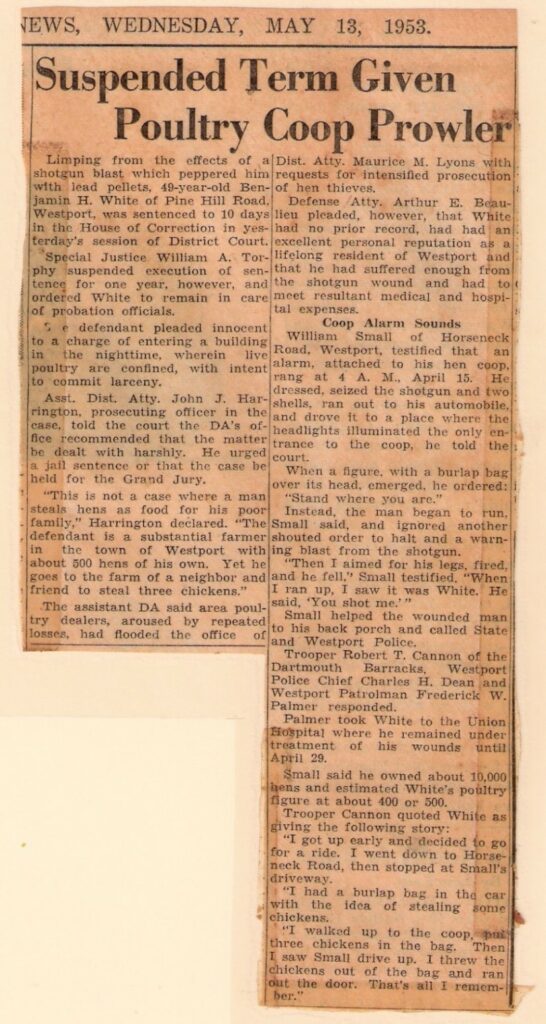
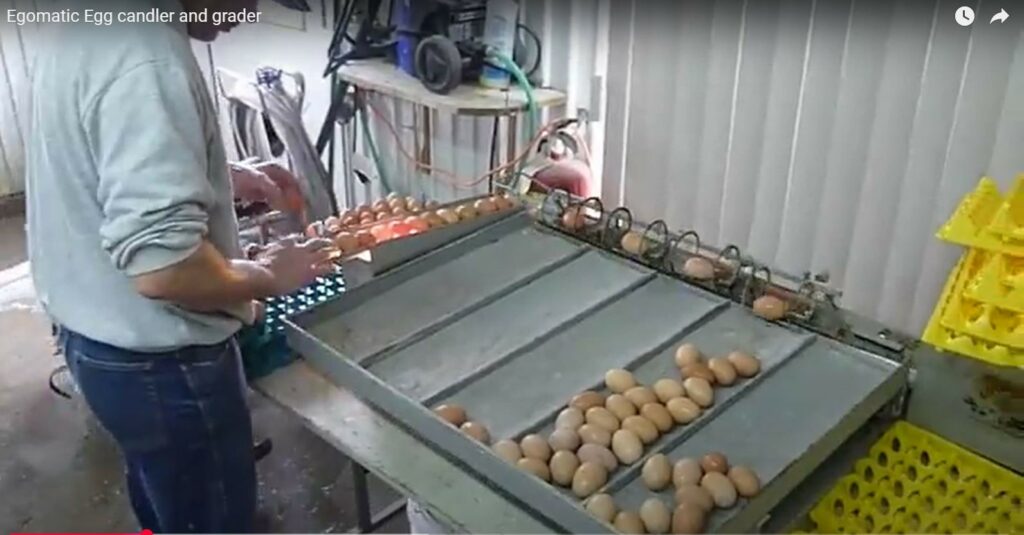
The machine above is similar to the one he used. Eggs were gathered three times a day by hand & put into wire baskets. The baskets were refrigerated until it was time to sort & pack the eggs, which was done once a day. They were individually put onto a chute which was slanted (the front being higher than the back) so the eggs would move to the back of the sorter. Once there, one at a time they travelled along the top where they were weighed. The weight of the egg would determine which lane they dropped off into. There were 4 lanes: small, medium, large & jumbo. Once sorted, each size was packed by hand into flats. There were 30 eggs per flat which equals 2.5 dozen. The flats were put into large cardboard egg crates/boxes – 2 rows in the box with 5 flats high equals 300 eggs per box. They were then sold to various markets.
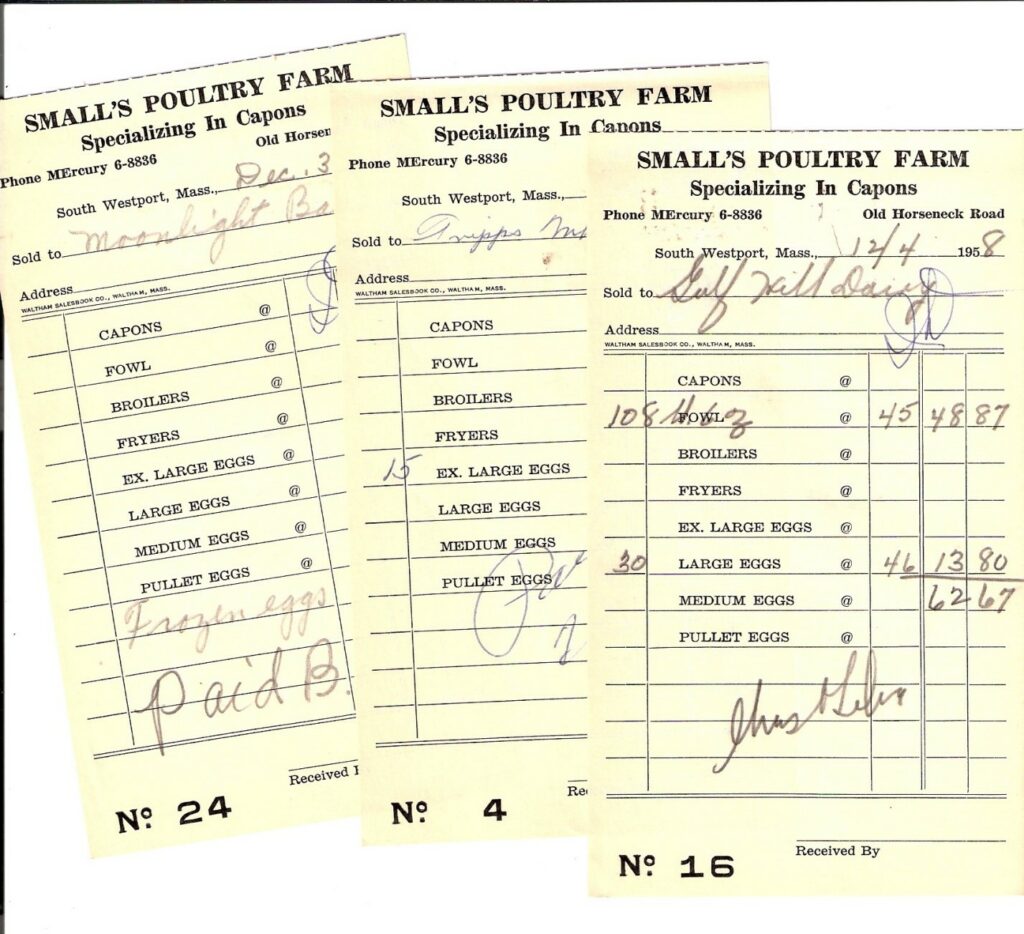
There was a raised area on each floor where the chickens would sit & sleep. This area built up with chicken droppings. Every week or so, this area was scraped of the droppings & they went down a hole where it landed in the manure spreader. Ronnie remembers the many times he would hook the spreader up to his Allis Chalmers tractor & spread it onto the fields. While the manure had an overwhelming ammonia stench, it was the best fertilizer for corn and grass.
The flocks were kept until the weekly egg count dropped off. When it did, the chickens were sold for meat, the entire chicken house floors were cleaned & new small chicks were purchased. For all the very hard work & hours that was put into raising chickens they were rewarded by selling a dozen eggs for .46 cents. A 30 dozen crate / box brought in $ 13.80 in 1958
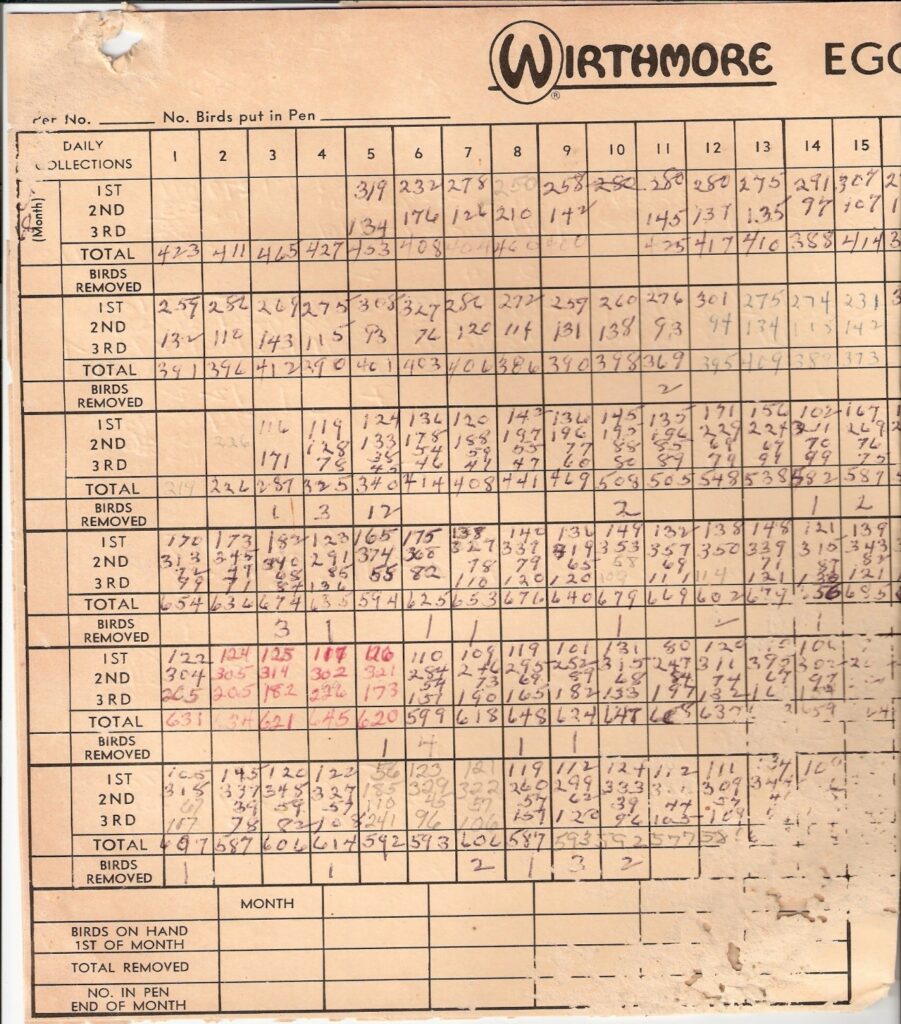
This is the final egg tally that was hanging on the wall when the last of the chickens were sold.
The last readable days on the tally totals 4131 eggs. This equals 13.77 crates which they sold for $189.75. As no records exists for the poultry farm, we have no idea as to what the expenses were, however, I have found the following:
- Chickens eat ¼ lb or ½ cup of feed per day or 1.5 lbs per week
- 100 chickens would eat 150 lbs per week
- 500 chickens would eat 750 lbs per week
- 1000 chickens would eat 1500 lbs per week. Grain came in 100 lb bags which equals 15 bags per week.
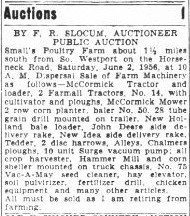
On June 2, 1956 Reuben auctioned his farming equipment. He retired and spent the winters in Bradenton, Florida where he died on 13 October 1962.
The business continued by Bill and his sons Ronald and Garry until the late 1960’s when it was closed as it was no longer profitable.
[1] www.247wallst.com
[2] www.dollartimes.com
[3] Kansas State Agricultural College, Agricultural Experiment Station, Bulletin 140, October 1906. Pg. 44
http://www.ksre.ksu.edu/historicpublications/pubs/sb140.pdf
[4] In today’s dollars, it translates to $ 272,000.00
[5] Pictures came from Westport Historical Society
[6] All of the newspaper articles contained within came from Reuben’s scrapbook. The book was falling apart and all the articles were falling out as they were scotch taped onto the pages. The dates and name of the newspaper was not kept by Reuben. It is assumed that they all came from the Fall River, Massachusetts newspapers.
[7] Fall River Herald News. 4 April, 1942. Pg 16
[8] Fall River Herald News. Sept 1941
[9] Fall River Herald News. 4 April 1942. Pg 16
[10] Fall River Herald News. 24 May 1941. Pg 14
[11] Fall River Herald News. 13 September 1941. Pg 14
[12] Tommy Small with dairy in background. He appears to be about 3 years old which would be 1946. Picture is from a collection belonging to Matthew Small.
[13] “Fall River Herald News”. 7 September, 1945. Pg 1 & 4
[14] Fall River Herald News. 7 September 1945 Pg 1
[15] Equivalent to about $ 124,000.00 in 2021
[16]Upright stone at gate with the year the house was built engraved into it.
[17] 1953 Board of Selectmen, pg 25
[18] Pat and Ronnie with their pet cows
[19] According to Dictionary.com a corncrib is defined as a ventilated structure for the storage of unhusked corn.
[20] https://www.youtube.com/watch?v=gmRBQj-3QRE
[21] “Fall River Herald News”. 1 June, 1956. Pg 35
